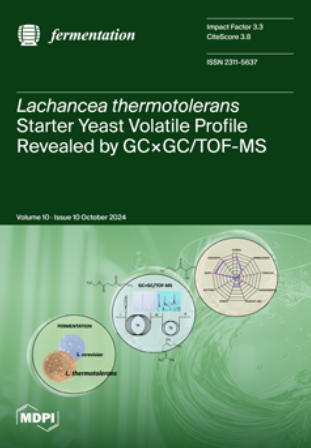Joint Multi-Optimization of an Extremophilic Microbial Bioanode for Mitigation of Mixed Hazardous Azo Dyes in Textile Synthetic Wastewater
IF 3.3
3区 农林科学
Q2 BIOTECHNOLOGY & APPLIED MICROBIOLOGY
引用次数: 0
Abstract
Bioelectrochemical systems (BESs), rather than physicochemical processes, are used for wastewater remediation, electricity production, and zero carbon dioxide emission. Textile effluents contain organic and inorganic compounds that can fuel BESs. The main goal of this study was to understand the interplay between the anode material, its surface area, the potential applied to the working electrode (WE), and the concentration of the co-substrate, and how these factors lead to the formation of highly efficient thermohalophilic bioanodes (THB) retrieved from Chott El Djerid (SCD) hypersaline sediment for the treatment of synthetic textile wastewater. To this end, twenty-seven bioanode formation experiments were designed using a Box-Behnken matrix and response surface methodology to understand concomitant interactions. All experiments were conducted in electrochemical reactors of final volume 750 mL inoculated with 80% of enrichment medium containing three azo dyes at a concentration of 300 ppm and 20% of biocatalyst microbial SCD source, at 45 °C. The optimal levels were predicted using NemrodW software as carbon felt (CF) anode material, 6 cm2 anode surface, 7 g/L glucose concentration, and −0.1 V applied potential. These theoretical results were experimentally validated, using maximum current output of 5.23 ± 0.30 A/m2, decolorization rate of 100%, and a chemical oxygen demand (COD) removal rate of 96 ± 1%. Illumina Miseq results revealed that bacterial community harbored the bioanode was dominated at phylum level by Firmicutes (67.1%). At the species level, the biofilm was mainly colonized by Orenia metallireducens species (59.5%). Obtained findings show a promising application of THB in the degradation of recalcitrant molecules as well as for the energy recovery.嗜极微生物生物阳极处理纺织合成废水中有害偶氮染料的联合优化研究
生物电化学系统(BES),而不是物理化学过程,用于废水修复、电力生产和零二氧化碳排放。纺织废水含有可为BES提供燃料的有机和无机化合物。本研究的主要目标是了解阳极材料、其表面积、施加到工作电极(WE)的电势和共基质的浓度之间的相互作用,以及这些因素如何导致从Chott El Djerid(SCD)高盐沉积物中回收的高效热卤性生物节点(THB)的形成,用于处理合成纺织废水。为此,使用Box-Behnken矩阵和响应面方法设计了27个生物节点形成实验,以了解伴随的相互作用。所有实验均在最终体积为750mL的电化学反应器中进行,在45°C下接种80%的含有浓度为300ppm的三种偶氮染料和20%的生物催化剂微生物SCD源的富集介质。使用NemrodW软件预测最佳水平,即碳毡(CF)阳极材料、6 cm2阳极表面、7 g/L葡萄糖浓度和−0.1 V外加电位。实验验证了这些理论结果,最大电流输出为5.23±0.30A/m2,脱色率为100%,化学需氧量(COD)去除率为96±1%。Illumina Miseq结果显示,在门水平上,厚壁菌门(67.1%)占生物节点所在的细菌群落的主导地位。在物种水平上,生物膜主要由Orenia metallireducens物种定植(59.5%)。研究结果表明,THB在降解难降解分子和能量回收方面具有很好的应用前景。
本文章由计算机程序翻译,如有差异,请以英文原文为准。
求助全文
约1分钟内获得全文
求助全文
来源期刊

Fermentation-Basel
BIOTECHNOLOGY & APPLIED MICROBIOLOGY-
CiteScore
3.80
自引率
18.90%
发文量
594
审稿时长
7 weeks
期刊介绍:
Fermentation-Basel is an international open access journal published by MDPI, focusing on fermentation-related research, including new and emerging products, processes and technologies, such as biopharmaceuticals and biotech drugs. The journal enjoys a good reputation in the academic community and provides a high-impact forum for researchers in the field of bioengineering and applied microbiology.
 求助内容:
求助内容: 应助结果提醒方式:
应助结果提醒方式:


